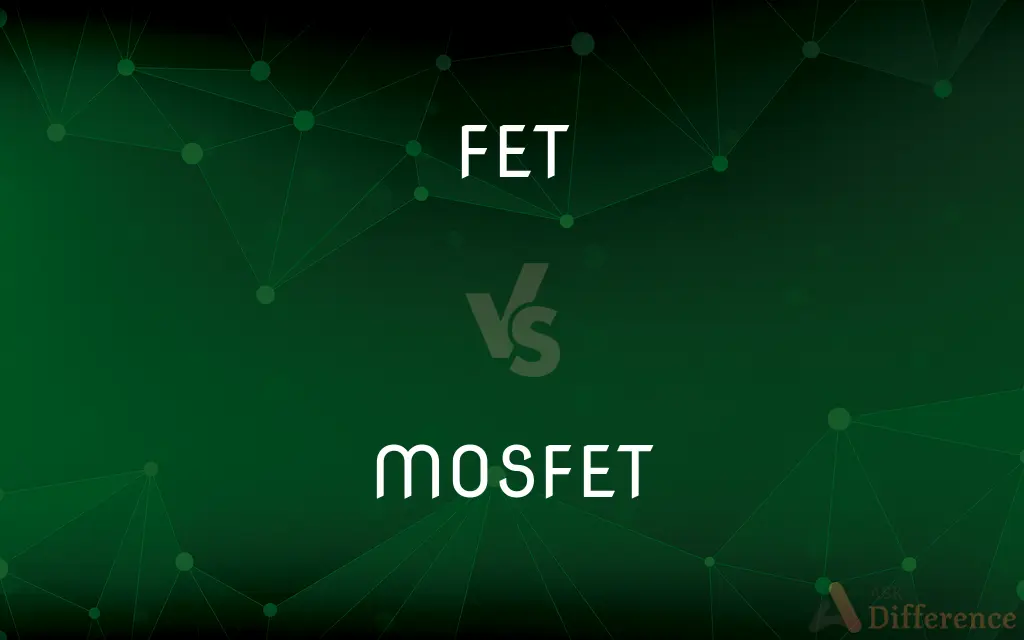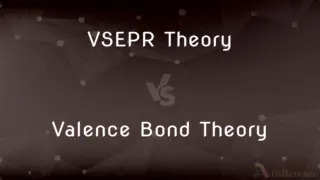FET vs. MOSFET — What's the Difference?
Edited by Tayyaba Rehman — By Fiza Rafique — Published on December 16, 2023
FET stands for Field Effect Transistor, a type of transistor using electric fields. MOSFET, Metal-Oxide-Semiconductor Field-Effect Transistor, is a specific type of FET with a metal gate, oxide insulation, and semiconductor body.

Difference Between FET and MOSFET
Table of Contents
ADVERTISEMENT
Key Differences
FET is a broad category of transistors that function using electric fields to control the flow of current. On the other hand, a MOSFET is a subtype of FET that employs a metal gate, an oxide insulator, and a semiconductor body to enhance performance.
The structure of FETs allows them to operate using the principle of electric fields, which makes them different from regular bipolar transistors. MOSFETs further refine this structure by incorporating metal-oxide layers, providing them superior switching speeds and lower power consumption.
Both FET and MOSFET devices are pivotal in modern electronics. While FETs, in general, offer high input impedance and low noise operation, MOSFETs are especially prevalent in integrated circuits due to their efficiency and compact design.
FETs have been a cornerstone in transistor technology for a long time. The invention of the MOSFET, with its added layers, marked a significant evolution, providing improved scalability and integration potential, essential for today's microelectronics.
While there are different types of FETs like JFETs (Junction Field Effect Transistors), the MOSFET stands out due to its unique structure and is further divided into n-channel and p-channel types, each with its specific applications.
ADVERTISEMENT
Comparison Chart
Basic Definition
Transistor using electric fields.
FET with a metal gate, oxide insulation, and semiconductor body.
Structure
Semiconductor material with source and drain terminals.
Incorporates metal gate, an insulating oxide layer, and semiconductor body.
Types/Subcategories
Includes JFET, MESFET, etc.
Includes n-channel and p-channel types.
Common Applications
Amplification, switching.
Digital circuits, power management, amplification.
Power Consumption
Generally low due to high input impedance.
Typically lower than generic FETs due to efficient design and fast switching capabilities.
Compare with Definitions
FET
An electronic component used in amplification and switching.
The FET served as an amplifier in the circuit.
MOSFET
A device known for low power consumption and high speed.
Due to its structure, the MOSFET offers rapid response times.
FET
A three-terminal semiconductor device.
The FET consists of source, gate, and drain terminals.
MOSFET
A transistor available in n-channel and p-channel varieties.
The designer chose an n-channel MOSFET for the specific application.
FET
A transistor that operates using electric fields.
The FET is favored for its high input impedance.
MOSFET
A prevalent transistor in integrated circuits.
The laptop's microprocessor utilizes MOSFETs for fast operations.
FET
A device controlling current without the need for input current.
The FET's voltage-controlled nature makes it efficient.
MOSFET
A subtype of FET with a metal gate and oxide insulation.
The MOSFET's design allows for efficient switching.
FET
A component providing voltage control of its operation.
The FET responds directly to changes in gate voltage.
MOSFET
A cornerstone of modern microelectronics.
As technology advanced, the MOSFET became indispensable in chip design.
FET
(obsolete) to fetch
MOSFET
A type of semiconductor field effect transistor used in integrated circuit technology that consumes very little power and can be highly miniaturized.
FET
(obsolete) a piece
FET
A piece.
FET
To fetch.
And from the other fifty soon the prisoner fet.
FET
Fetched.
FET
A transistor in which most current flows in a channel whose effective resistance can be controlled by a transverse electric field
Common Curiosities
How is a MOSFET different from a general FET?
A MOSFET is a specific type of FET with a metal gate, oxide insulation, and semiconductor body.
What does FET stand for?
FET stands for Field Effect Transistor.
What are the main applications of MOSFETs?
MOSFETs are commonly used in digital circuits, power management, and amplification.
Are all MOSFETs a type of FET?
Yes, all MOSFETs are a subtype of FETs.
Are there different types of MOSFETs?
Yes, there are n-channel and p-channel MOSFETs, each with specific uses.
How do MOSFETs enhance power efficiency?
MOSFETs have fast switching capabilities and low on-resistance, improving power efficiency.
Why are FETs used in amplification?
FETs have high input impedance and low noise, making them suitable for amplification.
Can FETs operate at high frequencies?
Yes, some FETs are designed to operate at very high frequencies.
Why are MOSFETs popular in modern electronics?
MOSFETs offer fast switching, low power consumption, and scalability.
What's the role of the gate in a FET?
In a FET, the gate controls the flow of current between the source and drain.
What does the "MOS" in MOSFET stand for?
"MOS" stands for Metal-Oxide-Semiconductor.
How many terminals does a FET have?
A FET has three terminals: source, gate, and drain.
Are there FETs other than MOSFETs?
Yes, there are other types like JFETs (Junction Field Effect Transistors).
What drives the operation of a MOSFET?
The voltage applied to the gate terminal controls the MOSFET's operation.
Why is input impedance important in FETs?
High input impedance means the FET doesn't load the circuit, preserving signal integrity.
Share Your Discovery

Previous Comparison
Holiday Inn Express vs. Holiday Inn
Next Comparison
VSEPR Theory vs. Valence Bond TheoryAuthor Spotlight
Written by
Fiza RafiqueFiza Rafique is a skilled content writer at AskDifference.com, where she meticulously refines and enhances written pieces. Drawing from her vast editorial expertise, Fiza ensures clarity, accuracy, and precision in every article. Passionate about language, she continually seeks to elevate the quality of content for readers worldwide.
Edited by
Tayyaba RehmanTayyaba Rehman is a distinguished writer, currently serving as a primary contributor to askdifference.com. As a researcher in semantics and etymology, Tayyaba's passion for the complexity of languages and their distinctions has found a perfect home on the platform. Tayyaba delves into the intricacies of language, distinguishing between commonly confused words and phrases, thereby providing clarity for readers worldwide.












































